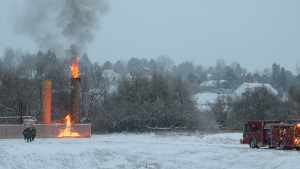A new report details technology and procedures the oil and gas industry is taking to lower emissions intensity.
The Canadian Association of Petroleum Producers (CAPP) released a report on July 21 titled, Canada’s Natural Gas and Oil Emissions: Ongoing Reductions, Demonstrable Improvement. The report cited several current technologies and developing trends the oil and gas industry is using to reduce greenhouse gas emissions (GHG).
CAPP vice-president of oilsands and fiscal and economic policy Ben Brunnen said the report identified emissions intensity as the most significant priority for the industry.
“The report showcases the performance of industry whether it’s oil and natural gas or in-situ or oilsands mining and it identifies some of the technologies that have been deployed to reduce GHGs,” Brunnen said. “What the report shows is that we’ve gotten some very good results.”
Brunnen said emissions intensity has gone down 32 per cent in the past eight years in the natural gas and liquids space largely due to technologies that reduce methane leaks, but also through increasing efficiencies at plants.
He added with regards to oilsands there’s been a 14 per cent reduction in mining emission with an eight per cent reduction in in-situ emissions over the last six years.
“For in-situ, some fo the technologies that have come to bear are steam displacement. How can you find a way to use less steam, which depends on natural gas for generation which creates the GHGs? Combining heat and energy is one of the top issues there and that’s co-generation, or else (you can) just maximize your loops by taking advantage of heat energy,” he said.
Brunnen also cited a technology called paraffinic broth treatment which uses hydrocarbon-based gravity separation to remove water and fine solids from bitumen froth produced in the oilsands mining extraction process.
“That creates a pipeline-spec product that can then be shipped without any further upgrading so that technology has actually been quite substantial in improving our emissions performance,” he said.
Carbon capture is another avenue the oil and gas industry is using to lower emissions, Brunnen said.
“Carbon capture is currently in operation. There’s one in Alberta through the Shell Quest project that is linked to their upgrader but also we have two in Saskatchewan that are in play. It’s not an insignificant cost from a technology perspective but it has the potential to really make a change in total emissions.”
Brunnen said the Shell Quest project removes CO2 during the internal process instead of after combustion which means more efficient capture.
“You can take CO2 out of a reaction within the facility and then sequester it. That generally gives you a higher concentration of CO2 and the higher the concentration the more efficient it is which is on balance a good thing,” he said.
The report also highlighted the importance of sourcing upstream electricity from low or non-emitting sources.
“If there’s access to electrification infrastructure tie-in, we look to Northern B.C. for example where some people have electrified their upstream facilities as a result of access to hydro-generated electrification. Instead of a gas-fired plant you have an electrified plant and that’s an emissions savings,” Brunnen said.
Companies are also testing zero-emission well sites, he added, “whether it comes from electricity or if it’s finding a way to maximize your efficiency with your production source. That’s still in development but it’s where the research is going.”
Brunnen also compared Canada to other jurisdictions and said the nation’s oilsands beat both the North American and the global average for emissions intensity.
“The fact that we have oilsands that are lower in intensity than the average for the globe is a testament to the work our industry has done to improve our efficiency,” he said.
He added no other jurisdiction undertakes the level of effort from a disclosure, investment and performance perspective than Canada does, so when we look at other jurisdictions we’re challenged because the data doesn’t give as an “apples to apples” comparison,” he said.
“We haven’t seen another jurisdiction where the industry presents the industry performance data in a way that demonstrates performance, transparency and accountability and makes a commitment to the continuous improvement that we do,” he said.
“What Canada’s oil and gas companies are doing is head and shoulders above any other jurisdiction.”
Listen to more from this interview in Friday’s Construction Record podcast here.
Follow the author on Twitter @JOCFrey.










Recent Comments
comments for this post are closed